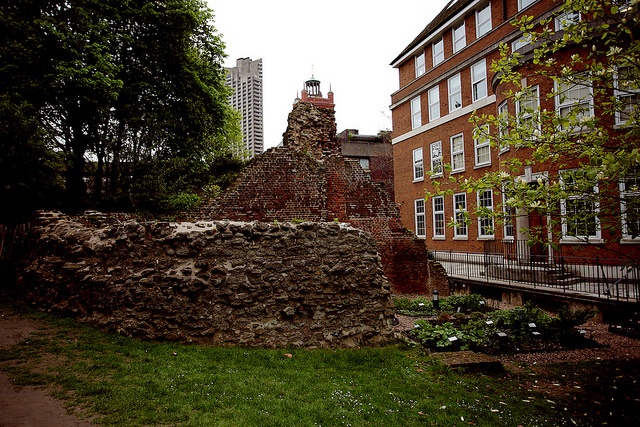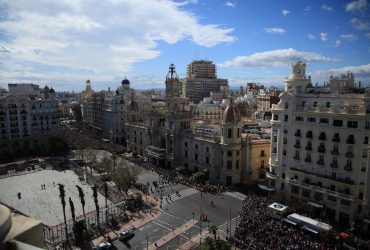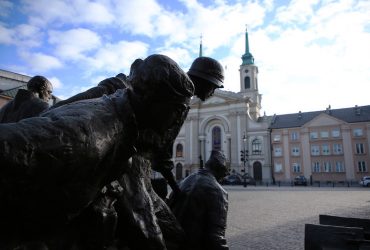In ancient times London was Londinium, under the control of the Roman Empire. During my last trip to London I found a fascinating book in the bookshop: more than 20 “theme” walks and divided by neighbourhood. I already knew that in London there are several remains of Roman times scattered around
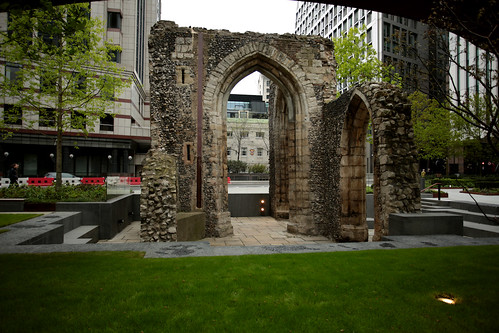 the city: looking at the map of the first walk proposed by the book, focused on what remains of the ancient Londinium I immediately realised that at least in part I wanted it (and “I had to “) do! I selected, therefore, some of the marked places to adapt the tour to my travel needs and I started the trip from St. Alphage gardens, a garden located in the heart of the City. Formerly it was the cemetery of the small church St Alphage London Wall, founded probably before the year 1000 and of which we find the remains of the tower.
the city: looking at the map of the first walk proposed by the book, focused on what remains of the ancient Londinium I immediately realised that at least in part I wanted it (and “I had to “) do! I selected, therefore, some of the marked places to adapt the tour to my travel needs and I started the trip from St. Alphage gardens, a garden located in the heart of the City. Formerly it was the cemetery of the small church St Alphage London Wall, founded probably before the year 1000 and of which we find the remains of the tower.
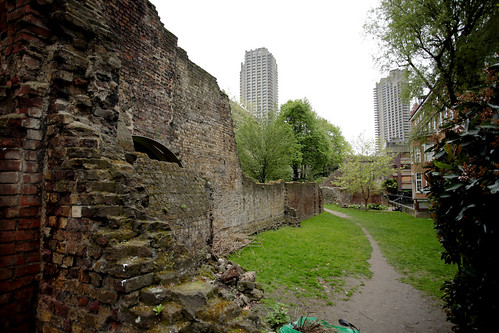 The cemetery became a public garden in 1872. Not far from the small garden, covered by the building of the London museum, are the Bastions 13 and 14. Walking along the ramparts, you can walk in the shade of a relatively long stretch of what were the walls of Londinium. I did not find much of the history of this stretch of wall, even though there were some explanatory plaques right next to both. The most striking thing is the powerful contrast with the buildings that surround them: all (hyper) modern, full of corporate offices, banks and insurance companies that have chosen the City as their “headquarters” in London.
The cemetery became a public garden in 1872. Not far from the small garden, covered by the building of the London museum, are the Bastions 13 and 14. Walking along the ramparts, you can walk in the shade of a relatively long stretch of what were the walls of Londinium. I did not find much of the history of this stretch of wall, even though there were some explanatory plaques right next to both. The most striking thing is the powerful contrast with the buildings that surround them: all (hyper) modern, full of corporate offices, banks and insurance companies that have chosen the City as their “headquarters” in London.
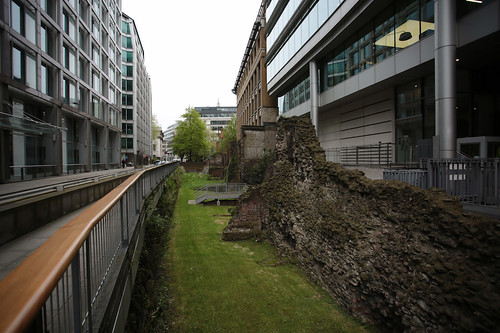 In front of the two bastions, along the Noble Street are the remains of walls including a tower dating back to 200 A.D. This part of the wall faces on the Clipplegate area, one of the eight ancient gates along the medieval walls. This part of the city, initially, was part of the fort built by the Romans in 120 and was then integrated into the new partitions as a northern gateway to the fort Roman where were the garrison for the defence of Londinium. The northern and western walls of the fort became an integral part of the London Wall and were then completely rebuilt during the medieval period. During the Second World War, unfortunately, the area was almost razed to the ground. The nearest underground stations are Moorgate
In front of the two bastions, along the Noble Street are the remains of walls including a tower dating back to 200 A.D. This part of the wall faces on the Clipplegate area, one of the eight ancient gates along the medieval walls. This part of the city, initially, was part of the fort built by the Romans in 120 and was then integrated into the new partitions as a northern gateway to the fort Roman where were the garrison for the defence of Londinium. The northern and western walls of the fort became an integral part of the London Wall and were then completely rebuilt during the medieval period. During the Second World War, unfortunately, the area was almost razed to the ground. The nearest underground stations are Moorgate
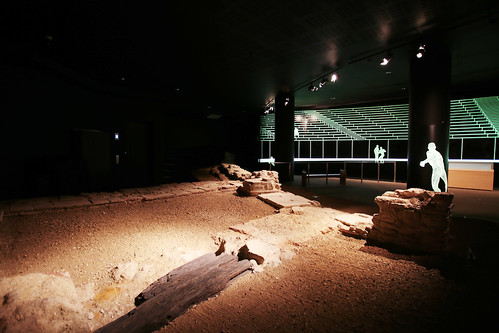 and Barbican. Practically by chance, reading the book I was talking about at the beginning, I discovered that there was also a Roman amphitheatre in Londinium. It was found in the basement of the Guildhall Art Gallery in 1998, during the improvement and expansion of the structure started in 1988. From the investigations made by archaeologists, it seems that this amphitheatre could accommodate about 25,000 people and that the inside arena measured 70 meters by 50 (the outer oval, probably, around 130 by 110). A critical testimony of the Roman period, the Londinium amphitheatre was built around 70 B.C. initially in wood, then it was renovated in the second century with tiled entrances and stone walls.
and Barbican. Practically by chance, reading the book I was talking about at the beginning, I discovered that there was also a Roman amphitheatre in Londinium. It was found in the basement of the Guildhall Art Gallery in 1998, during the improvement and expansion of the structure started in 1988. From the investigations made by archaeologists, it seems that this amphitheatre could accommodate about 25,000 people and that the inside arena measured 70 meters by 50 (the outer oval, probably, around 130 by 110). A critical testimony of the Roman period, the Londinium amphitheatre was built around 70 B.C. initially in wood, then it was renovated in the second century with tiled entrances and stone walls.
 The Guildhall Art Gallery, with free admission, is located in Guildhall Yard (near the Bank underground station) and is open every day. The small St. Bride’s Church is located in Fleet street (a small side street of the most famous and well-known street of the same name). The crypt preserves the remains of a building and a Roman floor dating back to the second century, in addition to the remains of 7 churches previously built on the same site.
The Guildhall Art Gallery, with free admission, is located in Guildhall Yard (near the Bank underground station) and is open every day. The small St. Bride’s Church is located in Fleet street (a small side street of the most famous and well-known street of the same name). The crypt preserves the remains of a building and a Roman floor dating back to the second century, in addition to the remains of 7 churches previously built on the same site.
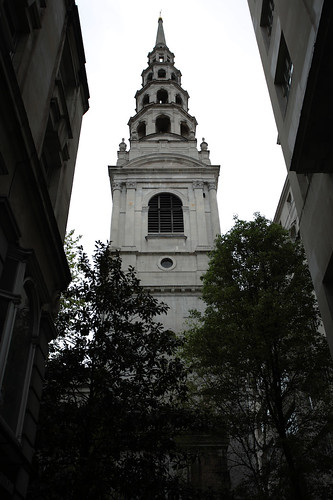 We know that this church was built on a pagan site dedicated to Brighde, the Celtic goddess of fertility and in the sixth century a church was built dedicated to St. Bridget (Irish goddess). The small church is nowadays known as the “church of journalists”: its name is due to its location along Fleet Street, the heart of English journalistic activity. The story around St Bride does not stop there, however, because there is also a little curiosity: a legend says that the English pastry chef William Rich took his bell tower when he “invented” the cake that is still used as a wedding cake!
We know that this church was built on a pagan site dedicated to Brighde, the Celtic goddess of fertility and in the sixth century a church was built dedicated to St. Bridget (Irish goddess). The small church is nowadays known as the “church of journalists”: its name is due to its location along Fleet Street, the heart of English journalistic activity. The story around St Bride does not stop there, however, because there is also a little curiosity: a legend says that the English pastry chef William Rich took his bell tower when he “invented” the cake that is still used as a wedding cake!
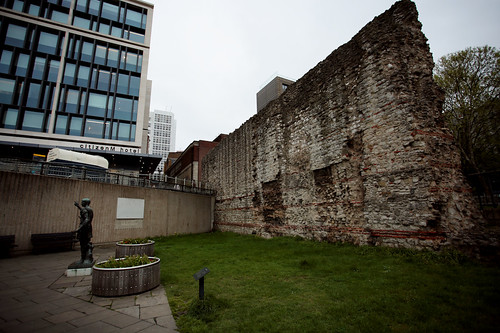 As soon as you exit the Tower Hill underground station, just before the underpass that leads to Tower Bridge, you will find a section of the ancient Roman walls. This piece remains from 200 D.C., and it was part of the defensive wall section that ran from Tower Hill to Blackfriars. Unfortunately, however, of the 10.6 meters in the height of the wall, only the lower 4.4 meters are from the Roman period: the upper part is from the Middle Ages (studies say that the Roman part is better built than the upper portion).
As soon as you exit the Tower Hill underground station, just before the underpass that leads to Tower Bridge, you will find a section of the ancient Roman walls. This piece remains from 200 D.C., and it was part of the defensive wall section that ran from Tower Hill to Blackfriars. Unfortunately, however, of the 10.6 meters in the height of the wall, only the lower 4.4 meters are from the Roman period: the upper part is from the Middle Ages (studies say that the Roman part is better built than the upper portion).
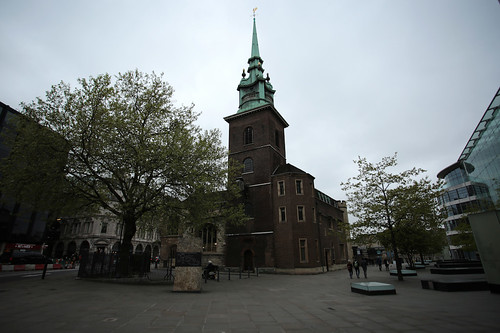 I conclude with the church of All Hallows by the Tower: classified as “grade 1” among historic buildings, this is one of the oldest churches in London. It was built in 650 AD and survived the famous and infamous London fire of 1666. It was founded by the Saxon Abbot of Barking on the site of a Roman building, whose remains are visible in the crypt, and inside it is still visible an arch from the Saxon era of 675 AD. Inside the crypt where you can even see the remains of the Roman building.
I conclude with the church of All Hallows by the Tower: classified as “grade 1” among historic buildings, this is one of the oldest churches in London. It was built in 650 AD and survived the famous and infamous London fire of 1666. It was founded by the Saxon Abbot of Barking on the site of a Roman building, whose remains are visible in the crypt, and inside it is still visible an arch from the Saxon era of 675 AD. Inside the crypt where you can even see the remains of the Roman building.
If you want to retrace the history of London from prehistory to the present day, I suggest you think about the “Museum of London”, which traces the history of the city.
London: looking for the ancient Londinium
